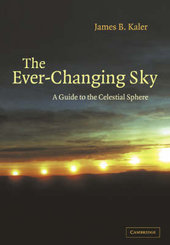
|
The Ever-Changing Sky: A Guide to the Celestial Sphere
Paperback / softback
Main Details
| Title |
The Ever-Changing Sky: A Guide to the Celestial Sphere
|
| Authors and Contributors |
By (author) James B. Kaler
|
| Physical Properties |
| Format:Paperback / softback | | Pages:516 | | Dimensions(mm): Height 245,Width 169 |
|
| Category/Genre | Popular astronomy and space |
|---|
| ISBN/Barcode |
9780521499187
|
| Classifications | Dewey:523 |
|---|
| Audience | | General | | Tertiary Education (US: College) | |
|---|
| Illustrations |
57 Tables, unspecified; 167 Halftones, unspecified; 143 Line drawings, unspecified
|
|
Publishing Details |
| Publisher |
Cambridge University Press
|
| Imprint |
Cambridge University Press
|
| Publication Date |
14 March 2002 |
| Publication Country |
United Kingdom
|
Description
The Ever-Changing Sky provides a comprehensive and non-mathematical guide to spherical astronomy. The reader is guided through terrestrial and celestial co-ordinate systems, time measurement and celestial navigation, to the prediction of the rising and setting of the stars, Sun and Moon. It focuses on the geometrical aspects of the night sky without using complex trigonometry. The book progresses to a general study of the Earth and sky, including the stars and constellations (with useful star maps provided), the motions and appearance of the Moon, tides and eclipses, the orbits of the planets and the smaller bodies of the Solar System (asteroids, meteors, meteorites and comets). Finally, there is a brief overview of atmospheric phenomena (including rainbows and haloes). This text will be invaluable to students taking courses in naked-eye astronomy, amateur and professional astronomers, as well as more general readers wanting to know how the night sky changes.
Author Biography
James B. Kaler is Professor of Astronomy at the University of Illinois where his research centres on dying stars. Professor Kaler has held Fulbright and Guggenheim Fellowships, and has been awarded medals for his work from the University of Liege in Belgium and the University of Mexico. As well as having published more than 100 research articles, he has written for a variety of popular and semi-popular magazines including Mercury, Astronomy, Stardate, Sky and Telescope, Scientific American, and l'Astronomia in Italy, and appears regularly on Illinois television and radio. His popular book, Stars, was published by Scientific American Library in 1992, and a new elementary astronomy textbook, Astronomy!, was published in 1994 by HarperCollins. Professor Kaler was also a consultant for Time-Life Books on their Voyage Through the Universe series. He is past president of the Board of the Champaign-Urbana Symphony.
Reviews'To write a book about spherical astronomy without confusing the non-specialist is far from easy; to do so without using any but the most elementary mathematics is indeed a daunting task. James Kaler has tackled the problem head-on, and has achieved a notable success ... All in all this is a fine book which fills a notable gap in the literature. It may be recommended without the slightest reservation.' Patrick Moore, The Observatory '... if you are looking for a good grounding in basic astronomy then look no further - The Ever-Changing Sky is the book for you! I only wish I had had it when I was trying to get a clear understanding of the celestial sphere fifty years ago.' Gordon E. Yaylor, Astronomy Now 'For all seriously interested in astronomy a good grounding in this subject is essential but in the past, due to its mathematical nature, this subject has been closed to many. Now, however, Kaler's book presents the entire subject in easy non-mathematical terms and he is to be congratulated for this achievement.' Irish Astronomical Journal '... a complete non-mathematical treatment of all aspects of the sky ... it contains many very interesting facts and figures which are certainly not to be found in the average present day book on popular astronomy.' Henry Hatfield, Journal of the British Astronomical Association 'Those non-mathematical readers who really want to understand the intricacies of phenomena such as the rising and setting stars, tides and timekeeping, calendars and constellations, planetary paths and eclipses need look no further than the superbly illustrated The Ever-Changing Sky.' New Scientist
|